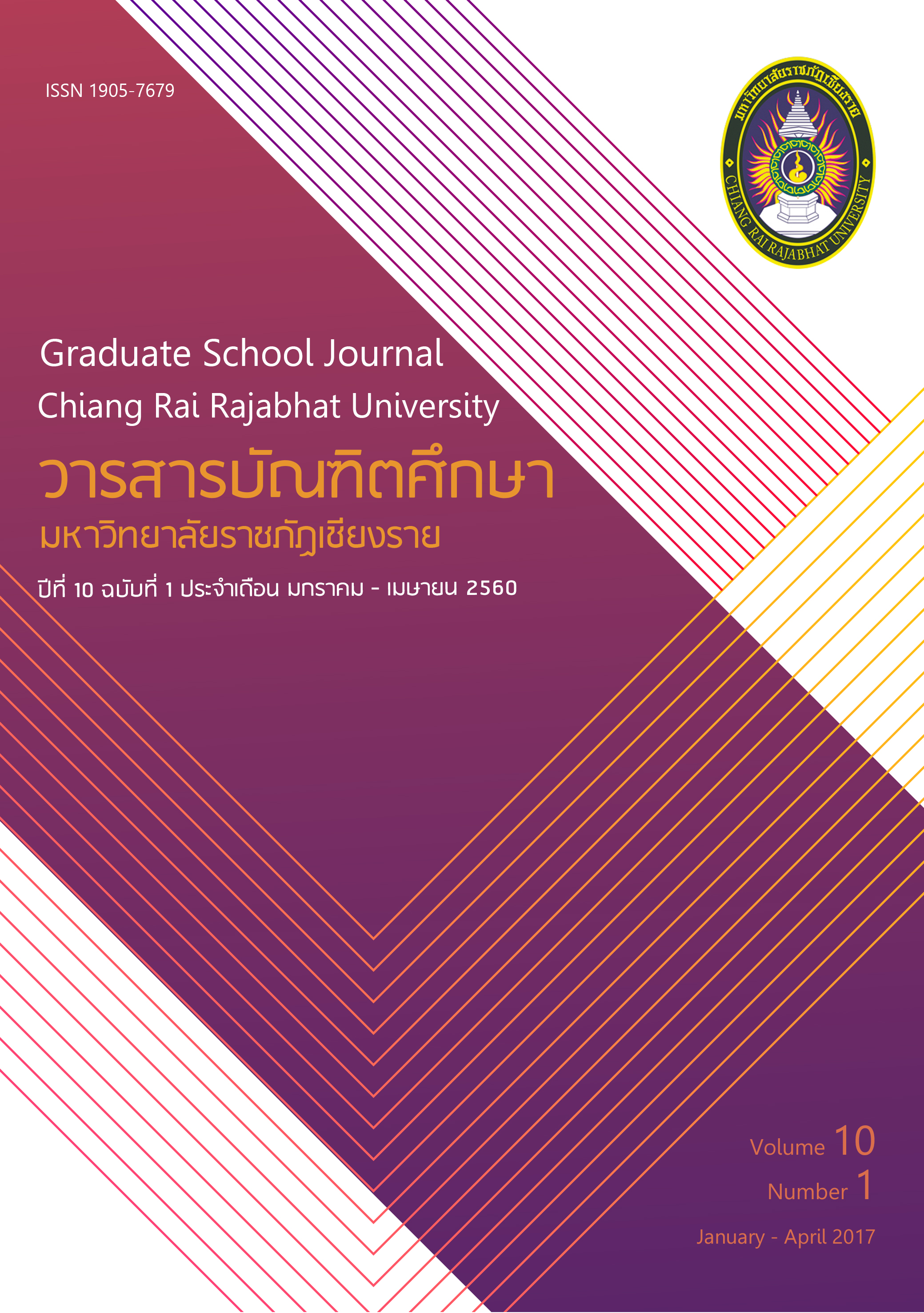Comparison of Learning Outcomes on Reading Comprehension of Prathom 5 Students under Learning Management Based on Mind Mapping versus STAD Techniques
Main Article Content
Abstract
The objectives of this study were: 1) to examine the effciency of the lesson plan
on reading comprehension of prathom 5 students between the learning managment based
on mind mapping and STAD techniques against the 80/80 standard criteria; 2) to compare
the learning outcomes on reading comprehension of prathom 5 students between the
learning management based on mind mapping and STAD techniques; and 3) to compare
the satisfaction of prathom 5 students toward the instructional management on reading
comprehension between mind mapping and STAD techniques. There were two sample
groups of prathom 5 students in their 1st semester of academic year 2014. The frst was
17 students from Sansaingam Wittaya School, Thoeng district, Chiang Rai province, in the
instructional management on reading comprehension using mind mapping technique. The
second was 18 students from Ban Huay Khrai School, Thoeng district, Chiang Rai province,
in the instructional management on reading comprehension using STAD technique. The
research instruments were lesson plan, achievement test, and questionnaire investigating
the students’ satisfaction. The data was analyzed using descriptive statistics including
percentage, mean, standard deviation, and t-test. The fndings showed that:
1. The instructional plan on reading comprehension of prathom 5 students based
on mind mapping showed the effciency at 83.27/83.95 while the effciency of STAD
technique was 82.89/83.60 in which the learning managment based on the two techniques
were higher than the 80/80 standard criteria.
2. The comparison results of reading comprehension of prathom 5 students
between the learning management based on mind mapping and STAD technique were
different. The learning outcome of the students after receiving the learning management
based on mind mapping was higher than those students under STAD technique with the
signifcance level of .01.
3. The satisfaction of prathom 5 students from Sansaingam Wittaya receiving the
learning managment based on mind mapping, in overall, the students held the satisfaction
at the highest level (= 4.56, S.D. = 0.57) while the satisfaction of the students from Ban Huay
Khrai School receiving the learning management based on STAD, in overall, the students
held the satisfaction at the high level ( = 4.21, S.D. = 0.75). So, the comparison of the
satisfaction level of the students from two schools based on t-test with the confdence
level of .05, the t-test score was 3.39 which indicated that the mean score of learning
managment based on mind mapping was higher than that of the learning management
based on STAD.
Article Details
บทความที่ได้รับการตีพิมพ์เป็นลิขสิทธิ์ของวารสารมหาวิทยาลัยราชภัฎเชียงราย
ข้อความที่ปรากฏในบทความแต่ละเรื่องในวารสารวิชาการเล่มนี้เป็นความคิดเห็นส่วนตัวของผู้เขียนแต่ละท่านไม่เกี่ยวข้องกับมหาวิทยาลัยราชภัฎเชียงราย และคณาจารย์ท่านอื่นๆในมหาวิทยาลัยฯ แต่อย่างใด ความรับผิดชอบองค์ประกอบทั้งหมดของบทความแต่ละเรื่องเป็นของผู้เขียนแต่ละท่าน หากมีความผิดพลาดใดๆ ผู้เขียนแต่ละท่านจะรับผิดชอบบทความของตนเองแต่ผู้เดียว
References
______ . (2549). การจัดสาระการเรียนรู้กลุ่มสาระการเรียนรู้ภาษาไทย. กรุงเทพฯ: กรมฯ.
ชวลิต ชูกำแพง. (2551). การพัฒนาหลักสูตร. มหาสารคาม: มหาวิทยาลัยมหาสารคาม.
ธัญญา ผลอนันต์. (2541). ใช้หัวคิด. กรุงเทพฯ: บูซาน เซนเตอร์.
บุณยภัทร สมเพชร. (2553). ผลการจัดการเรียนรู้แบบร่วมมือเทคนิค STAD กลุ่มสาระการเรียนรู้
ภาษาไทย เรื่อง การอ่านจับใจความสำคัญ ชั้นประถมศึกษาปีที่ 2 โรงเรียนบ้านวังผา
สำนักงานเขตพื้นที่การศึกษาประถมศึกษาเชียงราย เขต 2. (วิทยานิพนธ์ศิลปศาสตรมหาบัณฑิต).
มหาวิทยาลัยราชภัฏเชียงราย. เชียงราย.
วิมลรัตน์ สุนทรโรจน์. (2549). นวัตกรรมเพื่อการเรียนรู้. มหาสารคาม: ภาควิชาหลักสูตรและการสอน
คณะศึกษาศาสตร์ มหาวิทยาลัยสารคาม.
สุทธิ เหลืองอรุณ. (2550). การเปรียบเทียบผลสัมฤทธิ์ของนักเรียนชั้นประถมศึกษาปีที่ 4 ที่ได้รับการสอน
อ่านจับใจความโดยใช้นิทานอีสปกับนิทานพื้นบ้าน. (วิทยานิพนธ์ครุศาสตรมหาบัณฑิต).
มหาวิทยาลัยราชภัฏเทพสตรี. ลพบุรี.

